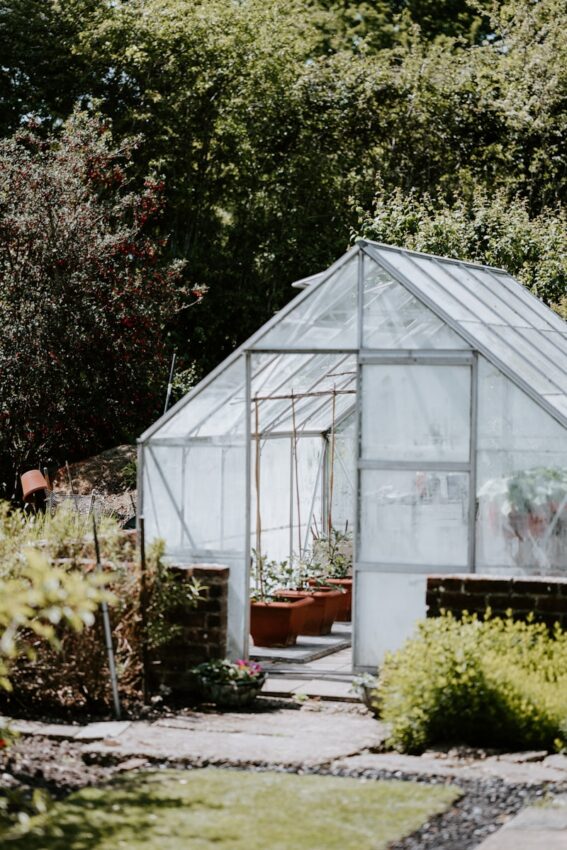Do you live in a region with a very short growing season and would like to enjoy fresh produce year-round? Greenhouses offer an easy way to extend the growing season and protect delicate plants from extreme weather. While they are worth the investment, the upfront cost of building a greenhouse can scare you off. Interestingly, adding a greenhouse to your backyard doesn’t have to be expensive.

Whether you are a beginner or a seasoned home gardener, building a custom greenhouse is a rewarding DIY project and a fantastic way to create space for growing veggies and ornamentals. With a DIY greenhouse plan, the right tools, and some basic construction skills, you can add a functional greenhouse to your backyard and take your gardening skills to the next level. Here are tips to build a greenhouse on a budget.
-
Choose a budget-friendly design
Greenhouses come in many shapes, sizes, materials, and designs. An easy way to save on construction costs is to skip complex designs with intricate cuts and opt for simple designs that require fewer materials and skills to build.
A-frame and hoop-house greenhouses are generally cost-effective because they require cheap and often readily available materials to build. They are also easy to construct, making them ideal for beginner gardeners. You can use wood and polythene sheeting to create a functional A-frame greenhouse, while PCV pipes offer an easy way to build hoop house greenhouses. The sides of these designs help in shedding snow, making them ideal for gardeners in areas that experience.
A lean-to greenhouse can be a cheaper solution if you want to build a greenhouse next to your house or garden shed. It allows you to utilize existing walls, cutting down on material costs. A lean-to greenhouse with study frames allows you to add shelves for starting seeds. You can also take advantage of the height to hang potted plants.
-
Recycling construction materials
A little creativity can do wonders when building a greenhouse. Repurposing wood, recycling storm windows and doors, or using salvaged plastic sheeting can be fantastic ways to cut costs while creating a functional gardening space. Pallets, scrap lumber, or even old fence panels can be used for frames, while plastic sheeting can be an effective insulator for your greenhouse walls. Salvaged wood can also be used to create raised beds and shelves. However, you should ensure the recycled wood you use is untreated and free from chemicals that may harm your plants.
If you have storm windows or doors, you can join them to create sturdy, transparent walls for your greenhouses. They offer excellent light transmission, necessary for photosynthesis and optimal plant growth.
If you are constructing a hoop house frame, old PVC pipes can be used to create sturdy frames. Excess hoses and pipes can also be perforated and used as drip irrigation lines, depending on how you want to grow vegetables and other plants in the greenhouses.
Besides being a cost-effective approach to building a greenhouse, recycling materials can add character to your greenhouse. It also helps reduce waste, promoting sustainability. Best of all, you can get most of the salvageable materials locally or from online marketplaces.
-
Consider a creative upcycled foundation.
While you need a solid foundation for your DIY greenhouse to ensure stability and longevity, it doesn’t have to be expensive. You can use bricks or pavers from demolition sites or recycling centers to create a stable base for your greenhouse. Remember to lay down a weed barrier and a landscaping fabric to prevent weeds from growing through the spaces. This layer creates a barrier between the soil and the floor of your greenhouses. Gravel from construction sites can provide adequate drainage.
You can also get creative and build a raised foundation with pellets. This will offer excellent drainage and air circulation, which can be beneficial for gardeners in areas with poor soil quality.
Regardless of the materials you use to create your foundation, make sure your greenhouse sits on level ground and keep in mind the importance of adequate drainage. Also, remember to inspect the materials you are using for damage and ensure they are safe for your plants.
-
DIY shelving and benches
Building a DIY greenhouse allows you to customize it to your needs. An easy way to customize your greenhouse and ensure you have enough space to start seeds for optimal harvest is by creating your own shelves and benches. Depending on your needs, you can maximize the vertical space by installing multiple tiers of shelving. But remember, you will need to access the shelves to tend to your plants, so don’t overdo it.
Installing shelves and benches requires basic woodworking skills and can be easily designed using reclaimed wood or PVC pipes. Pallets and scrap wood offer an easy way to construct benches. But ensure the wood you are using is solid enough to withstand weight.
-
Choose cost-effective coverings
When building your greenhouse, you can save money without sacrificing light transmission and insulation, which are essential for successful greenhouse gardening. Plastic sheeting is a cheaper way to cover your greenhouse and is widely available. You can further save on coats by checking for leftover rolls of plastic sheeting on local farms or construction sites. Despite being cheaper, plastic sheeting is UV-resistant and durable, so you can be sure to garden for a few years before you need to replace your greenhouse cover. Recycled windows or glass panels can also make an ideal greenhouse cover, but you need to find enough of them. They can also be heavy, making installation difficult. However, the cost of obtaining them beats the installation cost in the long term.
Conclusion
Building a DIY greenhouse can be a fulfilling project for gardeners who wish to extend their growing season. With some creativity and these cost-effective ideas, you can build a functional space where you can grow vegetables and other plants for year-round fresh produce. A customized greenhouse not only allows you to garden all seasons but also adds functionality to your backyard.
